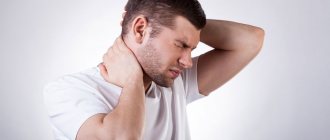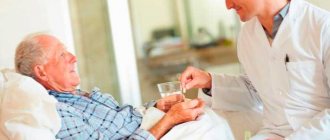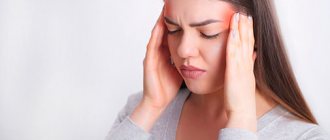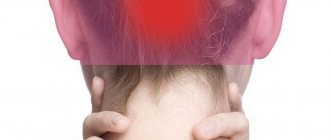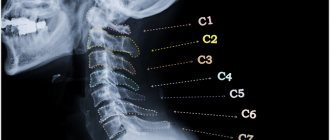Pain in the back of the head is a fairly common problem. And she has many reasons. Therefore, it is important to find their problems in order to feel relief. Let's find out together with a specialist how to do this.
Headaches in the back of the head can have several different causes. For example, it may only be muscle damage due to a minor injury, or it may be a secondary symptom of other pathologies. The type and location of pain can play a critical role in diagnosing the cause. If the pain is severe and repeated, be sure to consult a doctor.
Causes of pain in the back of the head in an adult
“Pain in the back of the head itself does not indicate the cause of this pain,” explains neurologist Elena Gaivoronskaya.
– The doctor assesses the frequency of pain, its intensity, duration, nature (pulsating, pressing, stabbing), associated symptoms. Only on the basis of all this data can a diagnosis be made. There are a number of reasons why headaches may occur predominantly in the back of the head.
headaches .
This is the most common cause of pain in the back of the head. Such pain can last from 30 minutes to 7 days. Such pain can be caused by severe stress, overwork, lack of sleep, malnutrition, poor posture or not drinking enough water.
Patients with this problem usually feel tension in the back or front of the head. The pain can range from dull to severe.
Migraine.
Another common type of headache that often appears in childhood and gets worse with age. Migraines are most common in women. Its symptoms include severe pain on one side of the head with nausea, vomiting and blurred vision. Patients are usually sensitive to light, noise, or smell. Physical activity may increase pain. It can last from several hours to several days.
Causes of migraines include emotional or physical stress, environmental and dietary changes. Sometimes medications (such as birth control pills) can also cause migraines.
Overuse of medications or recurring headaches.
These headaches can develop if a person takes too many painkillers. They are very strong and are often accompanied by nausea, anxiety, irritability, fatigue, difficulty concentrating, memory loss and even depression.
Occipital neuralgia.
A rare but severe headache that usually begins at the base of the neck and spreads to the back of the head and then behind the ears. Often occurs when the occipital nerves, which run up the back of the neck to the base of the skull, are damaged or irritated. The pain is accompanied by a burning or shooting sensation and persists on one side of the head, but often intensifies with movement of the neck. The patient is usually sensitive to light.
Possible causes include spinal injury, tumors, nerve damage caused by diabetes, swollen blood vessels, and rarely infection.
Headaches during physical activity.
They occur as a result of stressful activities and often occur after physical exercise. This pain resembles palpitations and can last from 5 minutes to 2 days.
Often occurs after heavy weight exercise or running. But sometimes they happen after sexual intercourse or pushing in the toilet.
Headache due to arthritis.
It appears in the back of the head and intensifies with movement. May be the result of arthritis of the first, second or third vertebra. Either it is associated with changes in the bone structure of the neck or inflammation of the blood vessels in the head.
In addition, the cause of a headache in the back of the head can be:
- osteochondrosis of the cervical spine;
- high blood pressure;
- increased intracranial pressure;
- stress;
- brain tumors;
- brain aneurysm;
- subarachnoid cerebral hemorrhage;
- cervical spine injuries and traumatic brain injuries;
- meningitis.
Causes of throbbing pain in the back of the head
Now let’s look at the main causes of throbbing pain in the back of the head - these are mainly diseases that require immediate treatment. But sometimes there are more prosaic reasons. For example, staying in an uncomfortable position for a long time, for example, during night sleep.
Most often, potential causes of throbbing pain in the back of the head include the following pathologies:
- injuries in the neck and back of the head (bruises, falls, sudden tilting of the head back, fractures, cracks, dislocations, subluxations, sprains and tendons, etc.);
- unstable position of the first cervical vertebra with periodic subluxations;
- fusion of the occipital bone with the first cervical vertebra;
- destruction of the joint between the first and second cervical vertebrae;
- degenerative dystrophic disease of the cartilaginous discs of the cervical spine (osteochondrosis);
- its complications, such as protrusion, extrusion and intervertebral hernia, including its sequestration;
- narrowing (stenosis) of the spinal canal, resulting in a sharp increase in intracranial pressure;
- displacement of vertebral bodies and intervertebral discs according to the type of retrolisthesis, antelisthesis, laterolisthesis;
- deformation of the ligamentous apparatus (the posterior and anterior longitudinal ligaments of the spinal column are attached in the area of the occipital bone; when they are damaged, throbbing pain in the back of the head is observed);
- pinching of paired cranial nerves;
- damage to the nerve plexus;
- inflammation of muscle fiber (including myositis ossificans);
- curvature of the spinal column, including in the thoracic region;
- Ankylosing spondylitis, systemic lupus erythematosus and other rheumatic pathologies;
- tumors and infectious diseases of the spinal cord membranes and its structure.
Potential causes are precisely those diseases that need to be further treated. There is no point in treating a throbbing headache in isolation. Any symptomatic therapy in this situation can be dangerous.
Here is a list of pathologies in which, after a throbbing pain in the back of the head occurs, the patient should immediately receive full medical care:
- spinal fracture (there is a danger of sudden cardiac or respiratory arrest);
- displacement of the vertebral bodies with compression pressure on the hard shells of the spinal cord (paralysis of part of the body may develop);
- increased blood pressure (high probability of transition to ischemic or hemorrhagic stroke);
- posterior vertebral artery syndrome (the process of blood supply to the posterior structures of the brain is disrupted);
- increased level of intracranial pressure.
It is also worth understanding that a throbbing headache in the back of the head may be a consequence of a developing migraine attack. Therefore, you should not engage in self-diagnosis. Contact experienced doctors.
Modern methods of treatment
Treatment methods depend on the diagnosis.
Tension headaches.
They are usually treated with painkillers, massage and sometimes meditation. However, frequent tension headaches require medical supervision.
Migraine.
Treatment for this disease includes painkillers and rest in a darkened room. Doctors often recommend lifestyle changes, hormone therapy, and anti-migraine medications such as triptans to reduce the frequency and intensity of migraines.
Returning pain.
The best treatment for this type of pain is to stop taking painkillers. Yes, at first the headaches get worse, but they go away quickly.
In severe cases, you should consult a doctor - physical or behavioral therapy may be required to break the habit of using analgesics.
Occipital neuralgia.
It can be treated with heat compresses, rest, massage, physical therapy or painkillers. Severe pain may require oral muscle relaxants, nerve blocks, steroid injections, or local anesthesia. In rare cases, surgery is necessary to relieve pressure on the nerves or block pain impulses to that part of the body.
Pain during physical activity.
Taking painkillers before exercise can solve this problem. In addition, it is important to avoid stress, eat right and get enough sleep.
Pain in the back of the head: if you have pain in the back of the head
Pain that occurs in the back of the head or in the upper neck is an extremely unpleasant phenomenon, aggravated by the difficulty of determining the location of the pain.
Causes of pain in the back of the head
There are several reasons why pain in the back of the head may occur. Let's look at some of them.
Diseases of the cervical spine (osteochondrosis, spondylitis, subluxations in intervertebral joints, sprains due to injury) - the pain will be localized in the back of the head, in the neck, and there may be increased pain when moving the head.
Cervical spondylosis refers to chronic diseases of the spine. In this case, osteophytes grow along the edges of the vertebral bodies. Many people interpret osteophytes as salt deposits. But that's not true. The appearance of osteophytes is associated with bone degeneration of ligaments. In most cases, the cause of spondylosis is age-related changes, but the appearance of this disease is also possible in younger people who lead a sedentary, sedentary lifestyle. Symptoms of cervical spondylosis, in addition to pain in the back of the head, are eye and ear pain, as well as pain in the shoulder girdle. In addition, neck mobility is limited and there is pain when turning the head.
Cervical myogelosis or muscle tightness. Myogelosis can occur from drafts, prolonged stay in an uncomfortable position, incorrect posture, and even under the influence of excessive nervous tension. Symptoms of myogelosis include: pain in the back of the head and shoulders, limitation of movements performed by the shoulders, dizziness.
Mental stress can be the result of stress, both acute and chronic. The risk of headaches due to stress increases from age 25 to 30. This is especially true for women.
Prolonged mental or physical stress, uncomfortable posture (for example, while driving or at the computer) can also lead to pain in the back of the head.
Neuralgia of the occipital nerve, the cause of which can be diseases of the cervical vertebrae, spondyloarthrosis, osteochondrosis, as well as hypothermia and colds. The pain in occipital neuralgia is paroxysmal in nature, it radiates to other organs: the ear, lower jaw, neck and back, sharply intensifies and becomes shooting when sneezing and coughing, turning the head.
Arterial hypertension also causes headaches localized in the back of the head. Most often observed in patients in the morning.
Cervical migraine, in which the patient feels a burning pain in the back of the head and temple, the pain can also spread to the superciliary region, often there is pain and a feeling of sand in the eyes, fog before the eyes, dizziness, and decreased hearing.
Vertebrobasilar syndrome - occurs as a consequence of osteochondrosis of the cervical spine. At the same time, some patients experience tinnitus, pain in the back of the head, a feeling that the world is “floating”, and a veil before the eyes. Characteristic signs are also nausea, vomiting, hiccups, paleness, double vision, hearing impairment, and some movement coordination disorders may occur. The diagnostic symptom of vertebrobasilar syndrome is a sudden fall and immobility in the presence of consciousness, which occurs when turning or throwing back the head.
Prolonged muscle tension as a result of improperly performed exercises. Tension headaches are characterized by a constant feeling of heaviness in the forehead and back of the head, which intensifies to a state of pain with fatigue, concentration, excitement, prolonged fixation of the head (when reading, writing, heavy physical activity). There is a feeling that something is pulling the head and pressing on it, as if some foreign body is in the forehead, crown, or back of the head. When pressure is applied to the muscles of the temples, forehead, back of the neck, the headache intensifies, dizziness and tinnitus appear. Limiting the mobility of the cervical spine reduces the intensity of headaches.
Popular questions and answers
We asked neurologists to answer questions related to headaches in the back of the head.
When can a headache in the back of your head be dangerous?
“Such symptoms,” says neurologist Olga Zincheva, “can include:
- concomitant increase in body temperature;
- weakness, awkwardness;
- numbness and tingling in the limbs or one limb;
- prolonged increase in pressure, difficult to reduce;
- severe headaches;
- headaches are accompanied by nausea and vomiting;
- double vision, impaired consciousness.
When to see a doctor for a headache in the back of the head?
“There are signs,” explains Olga Zincheva, “that require medical attention:
- you have a headache for the first time for no apparent reason;
- pain lasts several days;
- there are concomitant diseases.
“You need to go to the hospital immediately,” adds colleague Elena Gaivoronskaya, “if the headache occurs suddenly, it is very intense, there was no such pain before, or if the pain is accompanied by weakness in the limbs on one side of the body, a distortion of the face, speech disorder, or lack of coordination. If you have other alarming symptoms, you should consult a doctor as planned. You should also see a neurologist if you are taking too many pain medications or if your headaches are affecting your quality of life.
Treatment of throbbing pain in the back of the head
Treatment for throbbing pain in the back of the head can begin only after an accurate diagnosis has been made. You cannot take painkillers. Also, you should not correct high blood pressure levels on your own. There can be many reasons for its increase. And you need to influence them first.
In our manual therapy clinic in Moscow, you can undergo a course of completely safe and effective treatment for throbbing pain in the back of the head for a wide variety of diseases. We provide assistance to patients with pathologies of the spinal column. We also conduct rehabilitation courses for those patients who have suffered from cerebrovascular accidents.
We use only the most effective and safe methods of helping patients. Among them are:
- manual traction of the cervical spine - allows you to increase the intervertebral spaces to physiological sizes and eliminate compression from the radicular nerves;
- osteopathy - to restore the trophism of all tissues by stimulating the intensity of microcirculation of blood and lymphatic fluid;
- massage – to normalize the tone of muscles, ligaments and tendons;
- physiotherapy, reflexology, laser therapy, therapeutic exercises, kinesiotherapy and much more.
Contact us for high-quality and safe assistance. Our doctors have extensive practical experience.
